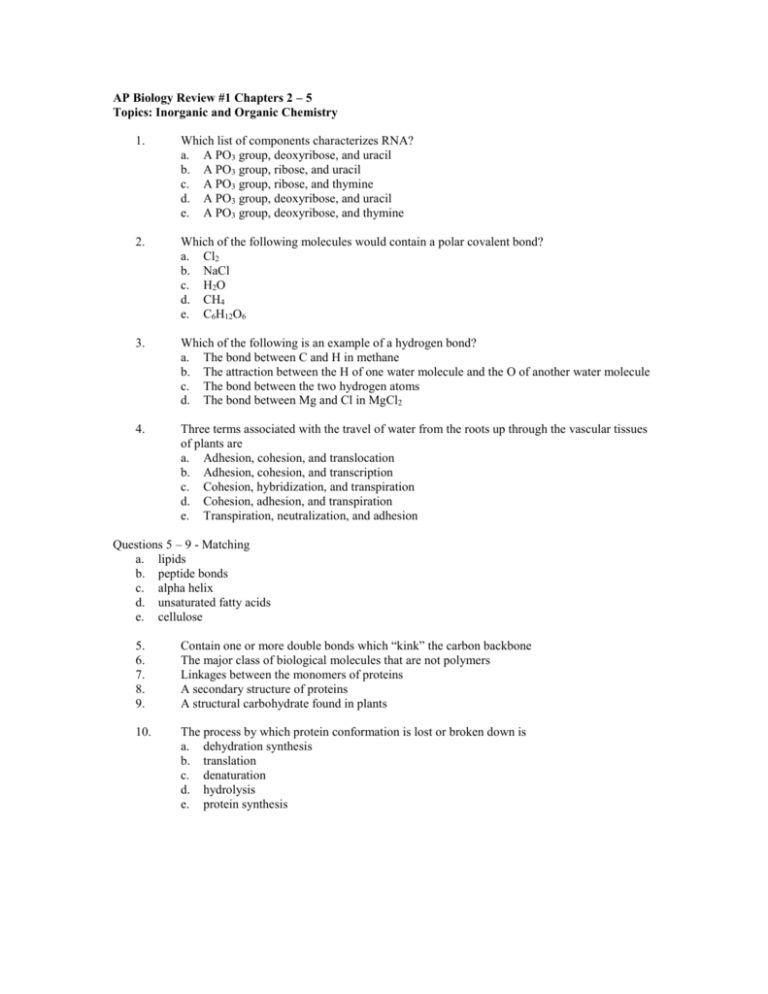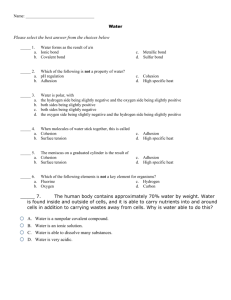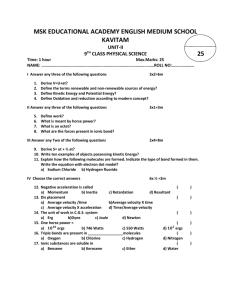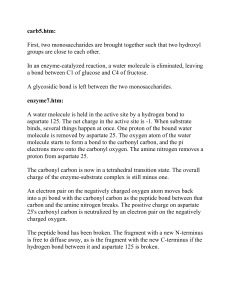AP Biology Review #1 Chapters 2 – 5
advertisement

AP Biology Review #1 Chapters 2 – 5 Topics: Inorganic and Organic Chemistry 1. Which list of components characterizes RNA? a. A PO3 group, deoxyribose, and uracil b. A PO3 group, ribose, and uracil c. A PO3 group, ribose, and thymine d. A PO3 group, deoxyribose, and uracil e. A PO3 group, deoxyribose, and thymine 2. Which of the following molecules would contain a polar covalent bond? a. Cl2 b. NaCl c. H2O d. CH4 e. C6H12O6 3. Which of the following is an example of a hydrogen bond? a. The bond between C and H in methane b. The attraction between the H of one water molecule and the O of another water molecule c. The bond between the two hydrogen atoms d. The bond between Mg and Cl in MgCl2 4. Three terms associated with the travel of water from the roots up through the vascular tissues of plants are a. Adhesion, cohesion, and translocation b. Adhesion, cohesion, and transcription c. Cohesion, hybridization, and transpiration d. Cohesion, adhesion, and transpiration e. Transpiration, neutralization, and adhesion Questions 5 – 9 - Matching a. lipids b. peptide bonds c. alpha helix d. unsaturated fatty acids e. cellulose 5. 6. 7. 8. 9. Contain one or more double bonds which “kink” the carbon backbone The major class of biological molecules that are not polymers Linkages between the monomers of proteins A secondary structure of proteins A structural carbohydrate found in plants 10. The process by which protein conformation is lost or broken down is a. dehydration synthesis b. translation c. denaturation d. hydrolysis e. protein synthesis 11. An organic compound that is composed of carbon, hydrogen, and oxygen in a 1:2:1 ratio is known as a a. Lipid b. Carbohydrate c. Salt d. Nucleic acid e. Protein 12. If three molecules of a fatty acid that has the formula C16H22O2 are joined to a molecule of glycerol (C3H8O3), then the resulting molecule would have the formula a. C48H96O6 b. C48H98O8 c. C51H68O6 d. C51H106O8 e. C51H104O9 13. Which of the macromolecules below could be structural parts of the cell, enzymes, or involved in cell movement or communication? a. Nucleic acids b. Proteins c. Lipids d. Carbohydrates e. Minerals 14. Which macromolecule is the main component of all cell membranes? a. DNA b. Phospholipids c. Carbohydrates d. Steroids e. Glucose 15. The partial negative charge at one end of a water molecule is attracted to a partial positive charge of another water molecule. What is this type of attraction called? a. A polar covalent bond b. An ionic bond c. A hydration shell d. A hydrogen bond e. A hydrophobic bond 16. Polymers of carbohydrates and proteins are all synthesized from monomers by a. The joining of monosaccharides b. Hydrolysis c. Dehydration reactions d. Ionic bonding of monomers e. Cohesion 17. If the pH of a solution is decreased from 7 to 6, it means that the a. Concentration of H+ has decreased to 1/10 of what it was at pH 7 b. Concentration of H+ has increased 10 times what it was at pH 7 c. Concentration of OH- has increased 10 times what it was a pH 7 d. Concentration of OH- has increased 1/7 of what it was e. Solution has become more basic 18. Which of the following is NOT considered to be an emergent property of water? a. Cohesion b. Transpiration c. Moderation of temperature d. Insulation of bodies of water by floating ice e. A versatile solvent 19. Which two functional groups are always found in amino acids? a. Amine and sulfhydryl b. Carbonyl and carboxyl c. Carboxyl and amine d. Alcohol and aldehyde e. Ketone and amine 20. Hydrolysis is involved in which of the following? a. Formation of starch b. Hydrogen bond formation between nucleic acids c. Peptide bond formation of proteins d. The hydrophilic interactions of lipids e. The digestion of maltose to glucose








